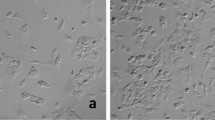Summary
A new human transitonal cell carcinoma cell line has been established in long term tissue culture. The BT-1 cells were derived from a poorly differentiated human bladder cancer. The tumor cell line produces tumors in nude mice. BT-1 has been characterized by cytogenetic and flow cytometric analysis and by isoenzyme typing. As in direct preparations of human bladder tumors, an isochromosome 5p is a consistent marker of the newly established line. The BT-1 cells produce transforming growth factors but do not respond to exogeneous EGF.
Similar content being viewed by others
References
Borden EC, Groveman DS, Nasu T, Reznikoff C, Bryan GT (1984) Antiproliferative activities of interferons against human bladder carcinoma cell lines in vitro. J Urol 132:800–803
Chen TR (1977) In situ detection of mycoplasma contamination in cell cultures by fluorescent Hoechst 33258 stain. Exp Cell Res 104:255–262
Deaven LL, Cram LS, Wells RS, Kraemer PM (1981) Relationships between chromosomes complement and cellular DNA content in tumorigenic cell populations. In: Arrighi FE, Rao PN, Stubblefield E (eds) Genes, chromosomes and neoplasia. Raven Press, New York, pp 4419–4447
Fogh J (1973) Contaminants demonstrated by microscopy of living tissue cultures or of fixed and stained tissue culture preparations. In: Contamination in tissue culture. Academic Press, New York, pp 65–106
Fogh J, Wright WC, Loveless JD (1977) Absence of HeLa cell contamination in 169 cell lines derived from human tumors. J Natl Cancer Inst 58:209–214
Gibas Z, Prout GR, Connolly JG, Pontes JE, Sandberg AA (1984) Nonrandom chromosomal changes in transitional cell carsinoma of the bladder. Cancer Res 33:1257–1264
Gibas Z, Prout GR, Pontes JE, Connolly JG, Sandberg AA (1986) A possible specific chromosomal change in transitional vell carcinoma of the bladder. Cancer Genet Cytogenet 19:229–238
Harris H, Hopkinson DA (1976) Handbook of enzyme electrophoresis. In: Human genetics, Chapt 4. Elsevier/North-Holland, Amsterdam New York
Human Gene Mapping 8 (1985) Helsinki Conference. 8th International Workshop on Human Gene Mapping. Cytogenet Cell Genet 40:1–823
Kimball ES, Bohn WH, Cockley KD, Warren TC, Sherwin SA (1984) Distinct high performance liquid chromatography pattern of transforming growth factor activity in urine of cancer patients as compared with that of normal individuals. Cancer Res 44:3613–3619
Koch H, Bettecken T, Kubbies M, Salk D, Smith JW, Rabinovitch PS (1984) Flow cytometric analysis of small DNA content differences in heterogeneous cell populations: human amniotic fluid cells. Cytometry 5:118–123
Kubbies M, Friedl R, Bettecken T, Hoehn H (1986) The fate of the primary diploid population during spontaneous transformation of growth factor supplemented murine cell cultures. Cytometry 7:551–557
Mac Pherson I, Montagnier L (1964) Agar suspension culture for the selective assay of cells transformed by polyoma virus. Virology 23:291–294
Messinng EEM, Bubbers JE, DeKernion JB, Fahley JL (1984) Growth stimulating activity produced by human bladder cancer cells. J Urol 132:1230–1234
Nickell KA, Halper J, Moses HL (1983) Transorming growth factors in solid human malignant neoplasms. Cancer Res 43:1966–1971
Roberts AB, Sporn MB (1986) Growth factors and transformation. Cancer Surv 5:406–412
Roberts AB, Lamb LC, Newton DL, Sporn MB, De Larco JE, Todaro GJ (1980) Transforming growth factors: Isolation of polypeptides from virally and chemically transformed cells by acid/ethanol extraction. Proc Natl Acad Sci USA 77:3494–3498
Robinson RA, Volkenant ME, Ryan RJ, Moses HL (1981) Decreased epidermal growth binding in cell growth arrested in G1 by nutrient deficiency. J Cell Physiol 109:517–524
Sandberg AA, Berger CS, Haddad FS, Kerr D, Hecht F (1986) Chromosome change in transitional cell carcinoma of ureter. Cancer Genet Cytogenet 19:335–340
Scatchard G (1949) The attractions of proteins for small molecules and ions. Ann NY Acad Sci 51:660–672
Sehested J (1974) A simple method for R-banding of human chromosomes showing a pH-dependent connection between R and G-bands. Humangenetik 21:55–59
Williams RD (1980) Human urologic cancer cell lines. Invest Urol 17:359–363
Author information
Authors and Affiliations
Rights and permissions
About this article
Cite this article
Heckl, W., Köhler, J., Hoehn, H. et al. Characterzation of a newly established human urinary bladder cancer cell line (BT-1). Urol. Res. 16, 23–29 (1988). https://doi.org/10.1007/BF00264624
Accepted:
Issue Date:
DOI: https://doi.org/10.1007/BF00264624




